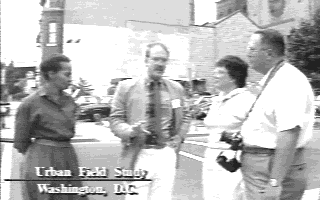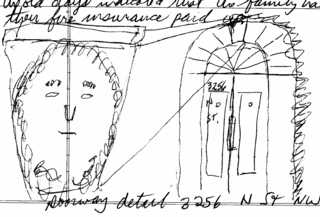National Geographic Society's
Summer Geography Institute (June - July 1991)
This document was last updated on 02 April 2001 (Ver. 1.2)
© Greg E. Nelson
Field Trip notes for 13 July 1991 WebQuest Lessons O.S.A.E. Lesson
Sometimes I hear the BBC news on WAMU, 88.5 FM, in the evenings, or CBC talk show. I told Jill B about listening to CBC and she asked about the fires there. I believe the golden panicles like those trees found in New Harmony are at the corner of 18th & I St., on GWU campus. We walked home last night past the Student Health. GWU is huge, has some interesting buildings. Just not time to see everything!
In our Cathy Riggs-Salter group today for the Georgetown Urban field walk were: Cheryl G, Kathy S, Bob A, Eric E, Karen H, Larry K, Susan B, Dick B, Angel R, Louise T and myself. The A part of Kathy's Group was Guy-Hansdorf. Many SGI's and their TCs met in the lobby of Everglades Hall, leaving about 8:15. We walked down H Street, past [the] Watergate, then NW to Washington Harbor and the sundial. We saw some catfish gatherers and their environment: Potomac River. We waited for Kit and Cathy who arrived just after 8:30. As he began to speak, a number of people extracted paper mache masks from bags and put them on their faces. Kit was speechless for about 30 seconds before continuing with his discussion. [I had seen some reference in the elevator to this project, but didn't have time to persue it].
We "peeled back the years" and talked about the Potomac, C & O Canal, tobacco, wheat. If you have to carry a crop more than two days, consider changing the crop. Wheat-flour, corn - whiskey, or the method of transporting it. Water transportation became essential to earn dollars. With the opening of the Erie Canal, for example, the price of cartage dropped from $100 per ton to $10 per ton. Great Falls, up river from here (Washington Harbor) was a huge barrier to transportation. With the introduction of water to Los Angeles, the population grew from 1,000 (in 1900) to 500,000 (in 1920) due to irrigation / potable water. One story is that $1 billion has been lost here in this Harbor area. Without fertilizer, tobacco is a shifting Third World agriculture, very labor intensive. We see here why Pentaquat [ we'd been reading Michner's Chesapeake ] wisely realized how his lifestyle was changing forever. The C & O Canal here was begun by G. Washington and stretched 184 miles to Cumberland MD, not that far from Pittsburg. The C & O was used for a century, beginning in 1824. Barges were broken up here and the lumber was sold. Dead heading was difficult. The canal began to lose its importance as some of the RR was built.
In 1871, Georgetown MD became the Port of DC. The New Deal era helped it grow, becoming a funky place to live. Today, a 900 [square] ft. real estate [property] will cost $800,000-900,000. When has land use intent failed? There are examples of that all around us. The Japanese now own Washington Harbor; some talk of turning it into something like Baltimore's harbor.
Look at the gentrification. Have fun, talk with your group leader (Cathy), have some cool drinks, lunch. Enjoy the atmosphere and challenges, reconvene near the Georgetown Mall at 2:15 for a sharing / debriefing.
Washington Harbor, fountain, shops, flood barrier, elevated highway - my sketch
In the courtyard above the fountain, near Thomas Jefferson and K Sts, we can see the chimney of an old coal fired power station. We stopped to talk with John H, a retired stone mason. He's from Dishley, Cheshire, England, and worked on the National Cathedral, from 1957 to 1977. He and his wife were removing the brick paving from that corner [Jefferson & K Streets.]. He's also worked in Turkey, Mexico, Belgium, Czechoslovakia, Germany, and many other places, mostly restoration work. He spoke about the nine years' program at the National Cathedral to get a group of apprentice stone masons in this country and "not a single person" stayed on past their nine week's course. He said we've lowered our standards so much not only in USA, but UK, everywhere. Mediocrity [is] especially bad in the lower grades. "Then rain, snow, or blow, I didn't make it except on my own!" The teachers in Fairfax County VA Tech Schools play cards, because they have no students who want to learn the crafts. My master could go to the pub ["Poob"] but not the apprentice. We had to stand erect, with cap in hand, when we spoke with the Master. We showed respect. We worked 50 hours per week then. Kit quoted a parent's teacher's lament on the decline of children's quality of work, lack of respect from 200 B.C.

John H smiled. He said, Who's to blame?" The parents. They are too soft with their children. I don't like this. Someone asked why he became interested in Stone Masonry. He said, "I'm the fourth generation in my family. I love it." My old folks were in the Guild. The Free Masons recalled the old ways, keep them alive. They were welcome anywhere, for they brought traditions, respect, the medicine bundle, they could translate several languages. They were involved in social reform and politics. They helped out families in need. The Sacred College of Masonry in England is not like the American version. I'm writing a book about stone masonry. There will never be another Cathedral built in the USA like the National Cathedral. All of the workers are dead (except John H, of course). The Indiana quarrymen are all dead or in their nineties. Of those who worked on the National Cathedral, 40% were Scots, 20% were Greeks or Italians, and the rest were Americans. The intellectuals don't appreciate us. There are not authentic iron workers, blacksmiths anymore. Most of this modern stuff is rubbish. He showed us his tools. Some were made by tempering in whale oil, made by real iron workers versus stuff made by industrial idiots. Notice my choice of tools. Here's a one pound chisel. It's much better made for my hand, for safety. Here's a Stanley [chisel], not so good. If you use a three pound hammer, you exert over 8 tons of pressure everyday and you are tired. In a craft school working with a Master, you learn to cut stone behind your back, while looking at the model. You don't look at what you're doing, but what the Master has done. Kit said some people look at their product without looking at their keyboard. John H said, "It's not the same." We found out that he'd written several articles for the NGS, so we'll look for them.
The sign on the red brick building across from our interview, Jefferson & K Sts., was "Jefferson Court MCMLXXXIV". We walked up Jefferson Street with Cathy Riggs-Salter, and our group then crossed the old C & O Canal, and I got pretty excited as I'd read about it, [and] seen old photos. The canal is now a tourist site here, has 90 minute rides, barges pulled by donkeys. We saw where they had been. Cathy gave us the second part of the field walk [handout], which included a scavenger hunt, see handout, map, which we are to bring to our debriefing, 2:15. We looked around the C & O. I want to return, then [we] walked up the hill to M Street.
We had mid-morning break with fruit juice and apple croissant at Au Croissant Chaud, 3222 N Street. [I] used Cirrus Atar [ATM] across the street. [We] walked over to the Old Stone House, (1765), 3051 M Street, and its beautiful garden in the rear. I passed an old fish shop with fresh seafood on display, past the Georgetown PO, 31 & N Street. We saw some beautiful old row houses, [set into] long narrow lots. One of the Qs was re real estate. We found out that real estate runs $135-215 [square] ft. with places running 900-3500 ft. in size. Fire marks in the old days indicated that the family had their fire insurance paid.

Sketch of Doorway detail, 3256 N St. NW
We talked about the role that landscape played in such a neighborhood. See also notes from May-June 91 trip to D.C. There is gentrification in [the] landscape. Mike Mulligan is in the basement of...
The Potomac Cafe, for example, serves Greek food. We saw the Strassi Gallery, former home of Marbury, owner of [the] home made famous by "Marbury verses Madison" Supreme Court Case. We were enticed into a below M St. Italian Restaurant for pasta and drink, away from the hot sunny pavement. Our group included: Bob A, Kathy S, Eric E, Susan B and myself. Deb R (TC from TX) and some of her friends wandered in later, and we gave them a tough time.
We had already been to the Georgetown Art Center, 1046 Potomac, and looked at old maps, lithographs, and postcards. Bob purchased over $100 of prints, while the rest of us were more restrained. We ended up under a shop covered porch for debriefing, but not before visiting Dream Dresser shop nearby. The D.D. is like some places in Kobenhavn.
We walked back to Washington Harbor, after our group talk. I did some reading while Angel took a nap. At 7:00, we were all nicely dressed, took the Metro to Farragut North, walked past NGS and Sumner School to the Governor's House, Holiday Inn, about 1 block north of Sumner/NGS on 17th St. We saw Bob S and Chuck G there, as well as other Alliance Coordinators. Some of us had a little bit of jealousy, having to share our wonderful SGI friends with people we didn't know. We got to meet a number of ACs and enjoyed our talk. We talked about our ASGI for next June, and I felt pretty confident in knowing what is involved. Our own SGI, TCs weren't there much. We had pizza & pop.
After our meeting, I worked on Mac project files at Sumner until about 11 PM, then ... later, back at the dorm, I spoke with some 'Glades Residents who were relaxing.
Thanks to Marie Nelson for typing up these notes on her Apple //e, summer 1991.
Back to Greg's Home Page Back to WebQuest Lessons Go to field trip notes for 18 - 22 July 1991.
(WQsgi910713.html)gen 02 April 2001